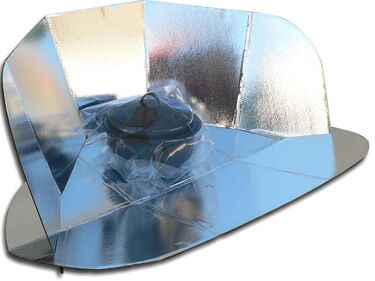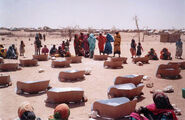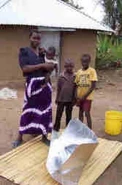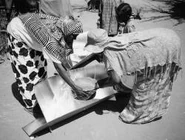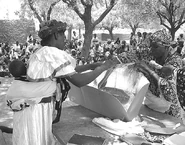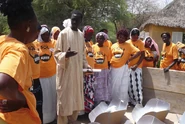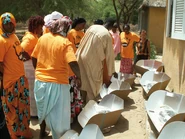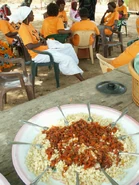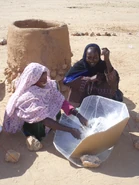Panel solar cookers are the first solar cookers that are truly affordable to the world’s neediest. In 1994, a volunteer group of engineers and solar cooks associated with Solar Cookers International developed and produced the CooKit, based on a design by French scientist Roger Bernard. Elegant and deceptively simple looking, it is an affordable, effective and convenient solar cooker. It requires a dark, covered pot and one plastic bag per day or one high-temperature plastic bag per month. With a few hours of sunshine, the CooKit makes tasty meals for 5-6 people at gentle temperatures, cooking food and preserving nutrients without burning or drying out. Larger families use two or more cookers. The CooKit weighs half a kilogram, folds to the size of a big book for easy transport. CooKits are now produced independently in 25 countries from a wide variety of materials at a wholesale cost of $3 - $7 US. We expect that the new hand-assembled CooKits will outlast the manufactured CooKits which last for two years. Note that you can either build your own CooKit using the plans below or you can order a pre-built Cookit from Solar Cookers International. Your purchase helps support SCI's work around the world.
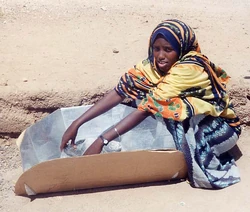
CooKits complement other cooking methods needed at night and on cloudy days. Coming about twenty years after the first efforts to replace open fires with improved cooking stoves, the CooKit uses no fuel at all. The CooKit is both user-friendly and environmentally friendly. Families can save scarce, expensive fuel for when they cannot solar cook and when economically capable, add other, higher cost cooking improvements such as modern biomass, smoke hoods, biogas, or liquefied petroleum gas.
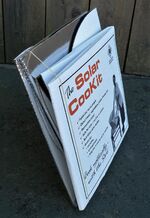
The CooKit folds to be about the size of a large notebook when not in use.
The value of CooKits is outlined in the following manner:
Addressing fuelwood scarcities:
- Solar cooking one meal a day, three times a week has been proven to reduce fuelwood consumption and related smoke by one third.
- The CooKit saves more than four times its value in fuelwood each year. With careful use and storage, a CooKit can be used for two years, reducing fuelwood consumption by two tonnes.
Improving health:
- The CooKit can pasteurize household drinking water, making it safe to drink.
- The solar cooking process is smokeless, reducing respiratory diseases and eye irritation
- Solar cooked foods retain vitamins, nutrients and their natural flavors; there is no smoky taste; the foods cook slowly in their own juices. Nutritious, slow-cooking traditional foods (beans, root crops, and some grains) are restored to the family diet
- Clean up is easy as the food never burns or sticks to the cooking pot.
- Solar cooks frequently report that the money they save on cooking fuel purchases is used to for many essentials, such as extra food, school supplies, and medical care.
- Without having to gather wood or dung, breathe smoke, and tend a fire – all associated with traditional cooking – solar cooking is easy and safe for people with AIDS and other illnesses, the elderly, disabled and young orphans.

Tying down a CooKit solar panel cooker so that it can withstand the winds at the Iridimi Refugee Camp where over 5000 CooKits are in use
Enhancing household and women’s economic status:
- The CooKit represents a new opportunity for women to capitalize on an underserved market and better meet their own cooking energy needs
- Solar cooking saves time as there is less need to tend a fire or collect firewood. A person can cook while at work, at the market, or tending crops. Young girls can attend school instead of searching for fuelwood.
- Solar energy is free and abundant in many areas of Kenya, providing a safe, clean, healthy supplement to traditional fuels.
Co-developers are Roger Bernard of France and Barbara Kerr of the USA, with work also by Ed Pejack, Jay Campbell, and Bev Blum of Solar Cookers International. Extensive field tests in the USA and in many developing countries confirm its performance, convenience, low cost, acceptance, and adaptability to diverse needs.
Construction plans

Plans for making a CooKit exactly as Solar Cookers International manufactures them. Start with a big piece of cardboard about 1m x 1.33m (3'x 4'). Cut and fold as shown. The angles and folds shown are best, but small variations are OK.
For detailed plans, see Solar Cookers: How to Make, Use, and Enjoy. This is a handbook published by Solar Cookers International that includes detailed plans for build a CooKit solar panel cooker. (There are also detailed versions in French, Arabic, and English for Kenya.)
Simple plans in other languages are available: German, Indonesian, Luo, Persian, Portuguese, Russian, Spanish
If you can't find a large flat piece of cardboard, consider building a Fun-Panel solar cooker instead or build one of the variations below.
Hints
- To make clean straight folds in cardboard, first make a crease along the line with a blunt edge such as a spoon handle, then fold against a firm straight edge.
- Make the slots a little too small and narrow so that they fit snugly to hold up the front panel.
- Glue aluminum foil on the side that will form the inside surfaces when the oven is set up for cooking.
- To set up, lay panel flat with shiny side up. Fold up front and back parts and fit back corners into the slots in front.
You're ready to cook! Put your food into a dark-colored pot. Then place the pot inside a plastic bag (an oven cooking bag will withstand the heat best). Close the open end of the bag and place pot and bag into the center of the cooker.
Plastic bags and other glazings
Place a dark-colored pot with a lid inside a plastic bag. Use an oven cooking bag alone or a normal plastic bag using a wire frame (see below) to keep the pot from touching the bag (to avoid melting the bag).
See main article: Glazing
Tips and Tricks

|
Dr. Steven Jones found that raising the pot on a wire frame improved cooking in a panel cooker. |
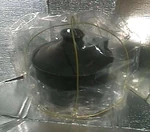
|
Wietske Jongbloed created a simple frame to allow the use of normal plastic bags (instead of heat-resistant oven cooking bags). |
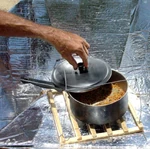
|
Jose Albano created this frame to protect normal plastic bags (photo shows frame with bag removed). |
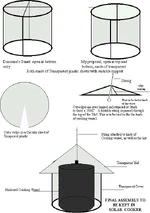
|
Dr. Ashok Kundapur has suggested a way to make a housing out of flat plastic sheeting. A bottom cylinder is supported by wire frame while a transparent cover, made of the same plastic material, makes access to the food very easy. This arrangement can also be used for retained-heat cooking. |
 
|
Stephen Harrigan found that discarded plastic phone cards, which are readily available in Africa, worked well to strengthen CooKits in their most vulnerable areas. See also Making the CooKit more durable. |

|
To remedy the moisture problem inherant in a product made of cardboard, the Solar Cookers International East Africa Office and colleagues have added notebook binding tape, also readily available in large cities or capitals to seal steno notebooks for students. |
See also
Buying CooKits
USA
- Order a pre-built Cookit from Solar Cookers International shipped from Sacramento, California. Your purchase helps support SCI's work around the world.
- Bulk purchases are also available:
- 1-3 units $25
- 4-9 units $20
- 10-24 units $17.50
- 25 or more $15
- Alternatively, if you are affiliated with a non-profit organization your price is automatically $15 per unit. For info about making a bulk purchase, write to sierra@solarcookers.org.
Kenya
- CooKits can also be purchased from the Solar Cookers International East Africa Office in Nairobi, Kenya.
Variations
Kundapur variation
Ashok Kundapur has designed this version of the CooKit that is easier mark and cut out of a single sheet of cardboard.
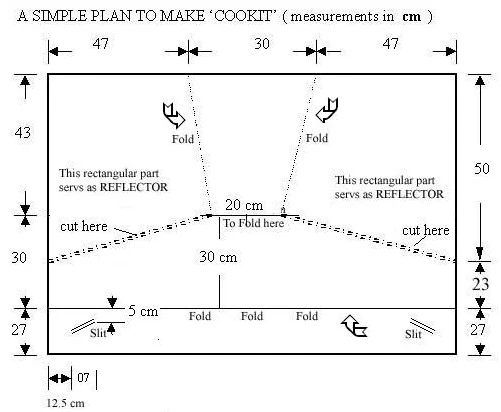
Manos Unidas variation
Solar Cookers International's standard CooKit calls for a lot of curves, which can be hard to make with a hand held blade. Juan Urrutia Sanz of the Manos Unidas organization in Spain writes that his group promotes a variation on the CooKit shape that is easier for many people to make at home. The Manos Unidas version, called Cocinsol II. Señor Urrutia y Sanz reports that it cooks as well as the CooKit and actually has more reflective surface area. SCI's Jay Campbell agrees. Jay is an engineer who has chaired the SCI Research Committee and who worked on engineering the CooKit for manufacture in Kenya. (One key advantage of the CooKit's curved shape is that it is easier to figure out a way to fold it into an album-sized package for easy storage and transport.) To make your own Cocinsol II, use the shape and dimensions shown in the graphic. Cardboard is an inexpensive material to use which holds its shape and is also easy to fold. However, woven mats or baskets, molded plastics or wood can be used. The solid lines in the design show where to cut; the dotted lines show where to fold. Cover the surfaces of one side with shiny material such as aluminum foil or shiny gift wrap (which will reflect light to the pot at the center of the cooker).
Diassana variation
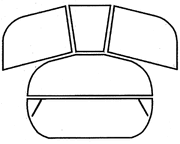
Figure 1
Mr. Gnibouwa Diassana, of Bla, Mali has been able to find sources for all the materials in or near Bla. “Cardboard is available in big towns,” he writes. “Plywood, glass, aluminum foil, sheet metal and plastic bags are available in Bla and neighboring towns.”

Figure 2
Mr. Diassana also applies creative thinking to obtain low-cost materials. He notes that tea, a very popular beverage in Mali, is shipped from China in boxes lined with aluminum foil which can be recovered and reused for making reflectors for solar cookers. “It works well,” he says.
What is lacking in Bla, however, are large pieces of cardboard. To adapt to this problem, Mr. Diassana makes solar CooKits from five pieces of cardboard (see figure 1), which he patches together using small thin pieces of cardboard or pieces of satin fabric (glued or sewn into place to hold the large CooKit parts together, see figure 2).
King variation
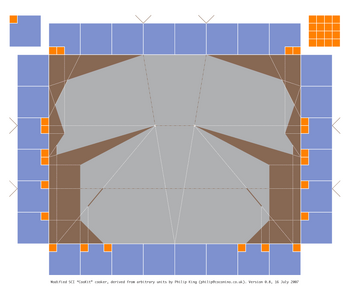
Detailed plan for building a CooKit of any size by using an arbitrary unit of measure
Philip King writes of his variation:
I've made one CooKit and wanted to make more, but each time I've looked at the published plans I've found that they don't suit my way of thinking. I also find them difficult to scale to suit an arbitrary size of material. So, and in case there are others like me who get dizzy looking at all those angles and inches and centimetres, I've drawn my own design with the following intentions:
- to use as few measurements as possible
- to use an arbitrary unit
- to find all angles automatically
- to use straight-line cuts throughout
- to use as few cuts as possible (I could still lose a few)
- to derive details easily without a template
- to eliminate guesswork or fudging
- to reduce the need for written instructions
I also wanted it to be as close as possible to SCI's classic and well-proven CooKit design but have some distinctive features of its own.
Of course, the production-line cookers are quite quickly made using templates, so this new plan has no advantage there. It is really intended to help those who are making a one-off cooker out of whatever randomly-sized material they happen to get hold of.
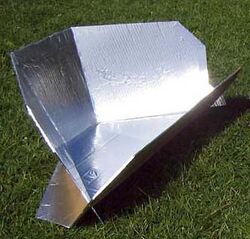
A completed CooKit made with this design variation
The design which follows is really meant for heavy corrugated board and not intended to fold to a small size (that's not to say it wouldn't if thin enough, I just haven't worked out yet how to derive the folds) and although the back angles are pretty close to the classic design they are different to a couple of degrees. The front panel is deeper and the back lower than in the classic, but not by much.
The chevron cuts in the ends of the side wings are to retain some surface area while also making the tabs narrower to fit the slots. I had an earlier design with a wider base and front panel to accommodate longer slots, but I like this one better, even though it adds a couple of cuts. The chevrons also satisfy my desire for a distinctive feature. The snips off the corners of the wings are to help with very stiff material when fitting the points into the slots; they don't really have to be measured, just a bit snipped off.
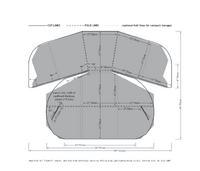
Diagram shows how this design compares to the standard Solar Cookers International design.
The basic unit is the orange block, and a unit size of 1.5 inches gives a sheet size of 48" x 36". Clearly, a unit size of 1" makes a sheet size of 32" x 24". Working in metric, a unit size of 4 cm yields a sheet size of 128 cm x 96 cm, which is about five per cent larger than the 48" x 36" sheet.
I have also made this plan available as a PDF file.
Having just made a full-sized example from this plan I can confirm that it is fast and accurate. However, I know how it's supposed to work, so I would welcome comments from anyone who tries to follow this plan to build a cooker.
Exernal links
- Scalable CooKit design simplifies measurements - Solar Cooker Review
- Full-resolution PDF file showing this design - Philip King
Poly-Furnace variation

The Poly-Furnace is made of polypropylene flute board.
In February 2008, Stephen and Sheila Harrigan shipped 275 of these durable plastic CooKits to the Sakali Refugee Camp in Sudan. The Poly-Furnace is a cut down model of the Cookit made by Solar Cookers International. Because of the adverse living conditions of the refugees in Darfur, Sudan the cardboard Cookit will not last much more than 6 months to a year. The need to have a durable Cookit has prompted us to develop one made of plastic polypropylene flute board. Reflective aluminum polyester is attached to the surface before it is cut and formed. A local group of volunteers have begun to make these for introduction into Sudan 2008. See also Making the CooKit More Durable.
Wooden variation
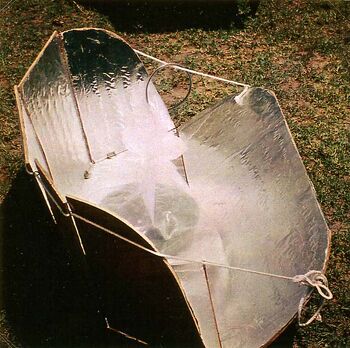
This CooKit is made of wood covered with aluminum foil.
Mass-producing CooKits
Audio and video
450px
| April 2008: The solar cooker students from last year are training their neighbors in the Sakali Refugee Camp near Nyala South Darfur, Sudan |
| Local Fabrication of the Cookit in Africa, Eritrea |
| September 2007: The CooKit being used in Chad refugee camp |
| Video showing how to make the Solar Cookers International version of the CooKit |
- The link below shows the animated result of a Simulation of a cross section of a CooKit. It does not include the power from the side reflectors.
Click here to play CooKit Profile Video
- This video shows the power contributed by the side reflectors. The display picture shows a view of each reflector. Each reflector is divided into pixels. Each pixel corresponds to an elemental area of the reflector. Black pixels define the extent of the reflector with a white line representing the boiundary between the rear and front portion of the reflector. Pixels corresponding to elemental areas from which reflected sun rays hit the pot are shaded. Rays from the white pixels hit the top of the pot. Rays from dark gray pixels hit the side of the pot. Rays from light gray pixels hit the bottom of the pot.
Click here to play side reflector video
See also
- Solar Cookers: How to Make, Use, and Enjoy - A handbook published by Solar Cookers International that includes detailed plans for build a CooKit solar panel cooker. (There is also a French version, an Arabic version, and a Kenyan-English version.)
- Directions for using the CooKit solar panel cooker
- June 2007: Research Study on Improvements to the CooKit Solar Panel Cooker Carried Out by Dr. Dale Andreatta and His Students in 2007 - Dale Andreatta
- May 2007: Making the CooKit More Durable - Stephen Harrigan
- July 2006: Optical Properties of the CooKit Solar Cooker - Ed Pejack
- 2006: A Report on the Evaluation of the KoZon Foundation Cookit Projects in Northern Burkina Faso - Jantje Struif Bontkes and Wietske Jongbloed
- February 2002: Tests of the CooKit conducted by the Florida Solar Energy Center
- Greenhouse enclosure comparison - Teong Tan
- The Fun-Panel solar cooker, which is similar to the CooKit, but can be made from a single cardboard box.
External links
- The Terra Foundation's data sheet on this cooker
- Order a pre-built Cookit from Solar Cookers International.
- Plans for the CooKit in many other languages
- April 2008: Interview with Linda Frederick Yaffe discussing what it's like to cook with a CooKit - Wildebeat
- April 2008: Natuurpunt Zuid-West-Vlaanderen starts a solar cookit project in Senegal (Dutch)

